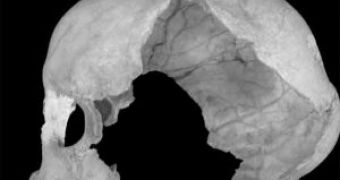Recently, archaeologists have dated six bones of early humans found in 1952 in the Pestera Muierii cave (literally: "Woman's Cave" in Romanian), Romania, to be 30,000 years old.
At the time of the bones' discovery, there was no carbon dating and they were not embedded in a rock layer that might have indicated their age. They essentially looked like those of an early modern human, thus they received little attention inside Romania and were unknown outside the country.
These are some of the oldest fossils of modern humans in Europe, few remains being dated as older than 28,000 years.
But analyzing the fossils' anatomy, Professor Erik Trinkaus from Washington University in St Louis and his team raised questions about the place of Neanderthals in modern human ancestry. Trinkaus' team presents - controversially - features that were characteristic for our evolutionary cousins, the Neanderthals (Homo neanderthalensis).
These anatomical features of the Romanian bones are either primitive or belong to Neanderthals. The fossil skulls present a large "occipital bun", a bump at the back of the skull, which is the result of differential brain growth and common in Neanderthal skulls.
Also, the arrangement of muscle attachment at the back of the jaw and shoulder blade are of Neanderthal type. "These data reinforce the mosaic nature of these early modern Europeans and the complex dynamics of human reproductive patterns when modern humans dispersed westward across Europe," wrote Trinkaus. "Strict population replacement of the Neanderthals is no longer tenable."
First Neanderthals were dated around 400,000 years ago and - at their peak - they roamed through a wide range, from Britain and Iberia in the west to Israel in the south and east to Uzbekistan.
Modern humans probably entered Europe from Africa around 40,000 years ago, and coexisted 10,000 years with the Neanderthals. The last Neanderthals survived in the Iberian Peninsula till 24,000 years ago. Many scientists think that Neanderthals were simply driven to extinction, by climate change or competition with the moderns, but some think they interbred with the modern human and contributed to the modern human gene pool.
The Romanian fossils seem to show that "at least in Europe, the populations blended," said Trinkaus. Comparing bones of Neanderthals, early modern humans in Africa before they spread, and Romanian fossils, Trinkaus' team found certain features that could have only come from the Neanderthals, because early modern humans lost them before spreading from Africa. "[the two groups] saw each other as socially appropriate mates," Trinkaus said.
The team points out that most closely related species that haven not been in a long time separation can still be inter-fertile (e.g. European and American bisons). Thus, European genetic pool must have some Neanderthal genes, in accordance with this study, though how much is uncertain.
Professor Clive Gamble, from Royal Holloway in London, UK, cautions about the evidence for interbreeding with Neanderthals, but agrees that the Romanian fossils hold valuable information. "We've known for some time that the earliest modern humans in Europe are a funny-looking bunch. They are a distinctive looking lot - very heavily built, particularly in the skulls," he told.
"The question is whether these robust features show that they were up to no good with Neanderthal women behind boulders on the tundra, or whether they were just a very rugged population."
"I think, really, the only way to tell would be to look at their ancient DNA. When DNA was extracted from the classic Neanderthal skeleton, the last ancestor between modern humans and Neanderthals turned out to have lived 600,000 years ago."
Similar mixed features - sapiens/neanderthaliensis - were found on European early human skulls from Mladec (Czech Republic) and the skeleton of a 25,000 years old male child discovered in 1998 at the Abrigo do Lagar Velho rock shelter (Portugal).
The Romanian fossils would be the oldest in this series.
Photo credit: Proceedings of the National Academy of Sciences

 14 DAY TRIAL //
14 DAY TRIAL //